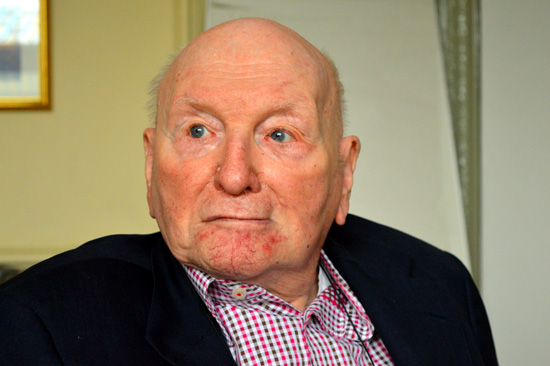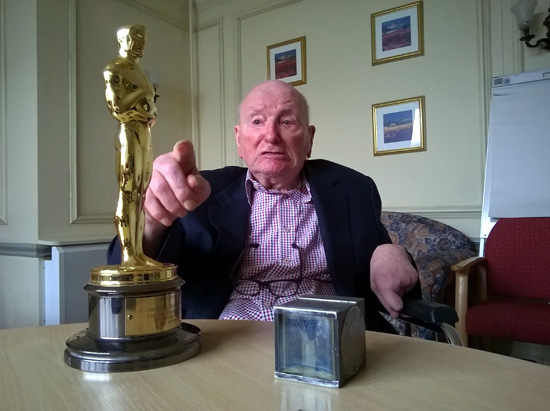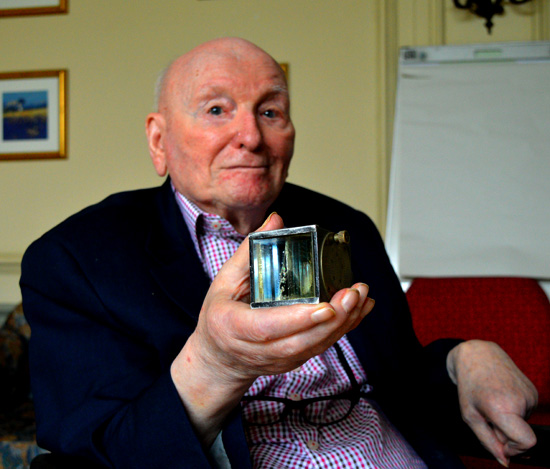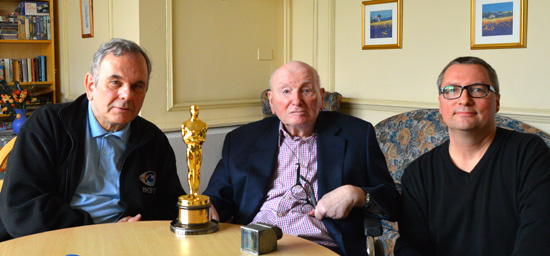A Lifetime with the Movies |
Read more at in70mm.com The 70mm Newsletter |
| Written by: Recorded Saturday 14. November 2014 in Stanmore, London, England. Retyped from audio files by Brian Guckian, Ireland. Edited for in70mm.com by Margaret Weedon & Mark Lyndon, London | Date: 16.08.2015 |
David W. Samuelson, 7. July 1924 - 28. October 2015 |
|
|
It was with great sadness that we learned of
the passing away of David Samuelson from his brother
Sir Sydney Samuelson.
It was a great privilege to have met him and to have been in the presence of
true greatness. As a tribute to his memory and achievements, our interview with David returns below. Our thoughts are with his family and friends at this time of sorrow. Mark Lyndon & Thomas Hauerslev |
|
 David
W. Samuelson, born 7. July 1924. David
W. Samuelson, born 7. July 1924.Thomas Hauerslev: David, it’s a great honour to meet you. You worked with CinemaScope lenses in the ‘50s and ‘60s? David Samuelson: I was a cinema newsreel cameraman, with Movietone, a Fox company. We covered the Ascot horse racing and I was assigned to film the time when the Queen went down and talked to all the jockeys. We had to film that from quite a long way away, although CinemaScope was about wide screen, it didn’t cross the management’s mind to equip me with a long lens. The only CinemaScope lens I had was a wide one, and the Queen was tiny, a long way away. I took the decision to go down from my assigned location to the ground level to film the Queen. I got into trouble because I had gone down and filmed the Queen as she walked past me as close as you are. My senior was a Yorkshireman, with a strong Yorkshire accent. I got a phone call from him that night saying: “Eee Sammy! What have you been doing?” He had been summoned to see the senior management at Royal Ascot. He had to explain why I was there. He asked me what he should say. The film was banned. They wouldn’t allow it to be used. And it’s never been used. But the Queen came past me as close as you are, and didn’t bat an eyelid, just walked past me. And it was a very good shot. TH: In CinemaScope. DS: It was certainly not what Fox intended! They wanted to have everything wide screen: which was why, in the early days, they only supplied wide-angle lenses. It wasn’t until Bausch & Lomb manufactured them that lenses were available in 50mm and 100mm. My Movietone camera had the eyepiece operating through the taking lens. So it could only be a wide picture, through that lens. The only thing I thought my senior could say was that when the Queen came past me her resulting image would be optically distorted. “Eee Sammy, I can’t say, ‘The Queen’s face was distorted’!” So it was banned. It was a shame, because it was a good shot, as she came within a couple of feet of me. We had made a special film of the events of the year, and Ascot racing was an important part of it. I reviewed it, and the shot wasn’t there. It had been censored out. TH: Can you remember...The Flying Enterprise, the ship that sank [10 January 1952]? The reason I am asking is that the Captain, Mr. Carlsen, was Danish. You were actually the man who photographed the ship going down. DS: I remember it very well. We were on a small boat with a radio playing a running commentary from a French news agency: “The Flying Enterprise is on its side! She is going down by the stern! The bow is up in the air”! The Captain and his mate jumped from The Flying Enterprise onto our tug. There were several Movietone cameramen available but it was my turn. I knew from a previous assignment on a lifeboat, that I would be very sick...and I was! I suggested to my non-suffering colleagues that another cameraman should go out instead of me; but I rang my wife that night and told her “If I don’t go – I’ll regret it all my life”. I would have done; so I stuck it out. You have seen the shot, with the bow rising, going past it with the name of the ship in sight. I did get that key shot. Until the very late days of my time with Movietone, it was the best event I ever filmed. I got an even better one later… |
More in 70mm reading: Visiting David Samuelson 20th Century Fox introduced CinemaScope in 1953 with "The Robe". Shortly thereafter, Panavision was born. A Conversation with Sir Sydney Samuelson about REAL PICTURE QUALITY: An Introduction The Trail Of The CinemaScope Holy Grail On the Trail of CinemaScope Internet link: louma UK Airshow DH 110 1952 Farnborough Airshow Disaster The Flying Enterprise Sinking Of Enterprise Pathe Visits Captain Carlsen |
 David
W. Samuelson with his OSCAR which he won in 2003 for the co-development of the Louma crane. Next to the OSCAR is one of Henri Cretien's original Hypergonar
lenses. David
W. Samuelson with his OSCAR which he won in 2003 for the co-development of the Louma crane. Next to the OSCAR is one of Henri Cretien's original Hypergonar
lenses.TH: Farnborough [6 September 1952] – tell me about that, please. DS: That was a bloody good shot, wasn’t it! I did not normally work on Saturday; I started my work during the week but I was sent that Saturday to do a crowd shot at the great air show! I picked out two ladies to do a close shot: while I was filming them they were watching the aircraft and shouted, “My God! He’s broken up!” I swung round, and this supersonic aircraft was coming down very fast and vertical. I knew from my own flying experience that the G-force from doing a 90-degree turn, when you’re flying that fast, would be enormous. It went up and then turned on it’s back and did another 90-degree turn and the G force was immense. It tore the jet engines out of their nacelles and they fell upwards! I had one of the very first opportunities to film the Red Arrows from the ground. After filming, they took us to lunch in the Officer’s Mess. After lunch I drove past a parked two-seater jet. It was a very new aircraft. I drove out of the airfield and turned into the first side road and waited until I saw all the competition – Pathé, Gaumont British and Paramount News – going past me. Then I went back to the Officer’s Mess and said, “I saw this new aircraft – could I fly in it with the Red Arrows?” The senior officer said, “Well that’s a good idea: I’ll see if I can arrange it”. But I had to wait for a pilot who was expert enough to fly with the Red Arrows. He was a wonderful guy, very young, who went on to be a very senior officer. I invited him home to dinner: when you have such a senior person to dinner it’s a very interesting experience. Of course, being the top guy, a truck came and parked outside my home. It had special control equipment installed since he was the officer who used to monitor the Russian over flights. The Russians used to fly over Denmark and, of course, there was always the danger they’d bomb Britain; and when you have such a senior officer to dinner, the RAF wanted to know who else would be at the dining room table! (It is all in my autobiography ...) TH: I remember from reading on the internet about you, when doing my research, that you often invited people home - you had invited a lot of Cinematographers amongst your guests. DS: Oh yes, at that time my wife was a wonderful chef and hostess. TH: May I ask you something else – something different? Did you start your career as a projectionist – did you run films as a projectionist in a cinema, like your brother Sydney? DS: My father was a very major early silent film producer. Then he absolutely ran out of money. As a result I had to leave my private school and go to work. The first job I got was on my fourteenth birthday. It was a very lonely job as an apprentice to a dental mechanic, working on false teeth and things. TH: Did you ever work in cinemas? DS: No, but I wanted to get a job in cinema. My father asked Sir Gordon Craig, who had been his partner, then head of Fox Movietone News, if he would give his son a job; so on my sixteenth birthday he gave me a wonderful apprenticeship. I spent three months in a projection box, which was a wonderful first place to be in, because I could look through the window and see all the coverage that other cameramen had done. After three months in the projection box, I had three months in the cutting room, which was a very, very useful experience as well. After the six months, I left Movietone to go into the Royal Air Force. TH: Did you fly in the Royal Air Force? DS: No, but I volunteered, for Aircrew. I must have been mad! I went for my first interview; they checked my eyesight and discovered that I couldn’t converge my eyes. For that reason I was unfit to be a pilot. But then they gave me an aptitude test and instead of being a pilot, they decided that I was fit to be a flight engineer. I knew they were absolutely right, that I had an engineering aptitude. I did an RAF engineering course to be an air crew engineer, which I have always said was my university, because in that room of twenty, where I slept, my hut-mates were mostly ex-university people - and it rubbed off! |
|
 David
W. Samuelson with one of
French inventor
Henri Chretien's original Hypergonar lenses, which
later became one of the first CinemaScope lenses. David
W. Samuelson with one of
French inventor
Henri Chretien's original Hypergonar lenses, which
later became one of the first CinemaScope lenses.TH: May I jump forward a bit? Do you remember Freddie Young? Freddie was your “daddy”. DS: Yes, a close friend. Freddie was a lovely man. He was the only British cinematographer to get three Oscars. He usually got all his equipment from us. It was mainly Panavision cameras and lenses; once, while he was at the office, he spotted a lens on the side, a 9-inch Dallmeyer, which even then was fairly old. He picked it up and said, “I’ll tell you what I’ll use it for. I’ll take that lens as well”. And it turned out that he did use it later, one of the most famous shots in the whole of cinematography. In “Lawrence of Arabia” – the actor came up directly towards the camera and Freddie had the lens on. Yes, bang out of focus, but a very famous shot, foreshortened, of Omar Sharif, on a camel, riding towards the camera. Freddie won an Oscar for his brilliant work. There is a big painting of that "Lawrence of Arabia" shot in the entrance hall of Panavision; and yet I know it wasn’t shot on a Panavision lens, it was shot on a Dallmeyer, not a very good lens! And yet it gave it the foreshortening. It was a very long lens. TH: He also filmed "Doctor Zhivago" [in anamorphic Panavision] and "Ryan’s Daughter" in 65mm [Super Panavision]. DS: DS: He won three Oscars, but there was something else that he did. He was asked to shoot a test film. We were asked to give studio facilities. Somebody of his calibre didn’t normally shoot tests. The film was “A Woman Called Golda” with Ingrid Bergman playing the person who, of course, was most important in the foundation of Israel. It was the last film she did. That’s my other Freddie Young story! Freddie did it for us. To do a test was a pretty lowly thing to do. Certainly you wouldn’t normally employ a triple Oscar winner to do it. TH: What other memorable experiences have you had in your career? DS: I worked for two years on "Candid Camera", and then "World in Action". That’s where my knowledge that I had picked up at Movietone, in the cutting room, came in handy. I had watched Sid Wiggins, the chief editor there, at work. I learned how to use a cutaway which is applied when they have to edit a shot that was too long; it enables them to cut a minute or two out of the finished reel. That is what I was doing on the Farnborough footage. They wanted to cut the running length of the reel down; and there was a shot of this supersonic aircraft, going down the runway...very, very fast. Before it took off, I had to pick out some young ladies so they could cut that in to the supersonic aircraft footage without a jump cut. Halfway through doing that they cried: “My God! He’s broken up!” I quickly took the wide-angle lens off, which I’d been using to film the young ladies, to catch the aircraft breaking up. (I have still got those lenses on my camera). I was always a bit lucky in my filming, and knew that what I was doing was something they could make into a film. The thought crosses my mind. I had a bloody good career, what with "Candid Camera", and "World in Action"... Mark Lyndon: You would have known Jonathan Routh? DS: I worked with him for two years. ML: In "Candid Camera", they persuaded some people to prop up Nelson’s Column. They said it was falling over! DS: A typical stunt that we did! The best one we did, was the last one, with Bob Monkhouse. He played somebody who has been having a duel. The duellists came by taxi and asked the taxi driver to wait. “One of us will be coming back” said Bob. Jonathan was a proper English gentleman, with a bowler hat. Bob had a duelling scar and a pretty strong accent. Then they went off for a walk, sat in a chair, wandered up the hill a little bit, then came back and said, “We’ve had a good talk together, and we made good friends. How much do we owe you?” By then there had been a bit of waiting time on the clock. They argued over who was to pay the fare. “No - I called the taxi driver: it’s my honour to pay!” And then the next thing is, they’re going to have a duel over who was to pay the taxi driver! But that was Candid Camera. One of the things I was jolly good at, I think, because I had spent so long in the cutting room. I did zoom lens shots. I put them in where they could cut without a jump cut. What I would like to know is, would one of you like to publish my biography? It’s called: “Dear God, Don’t Let It Sink Until I Get There”! - which is on the cover of the book, with the picture of The Flying Enterprise sinking. What I want to do is publish the book and get permission from Fox to put stills in from the original footage. |
|
 From
left to right, the two French inventors of the Louma Crane Jean-Marie Lavalou
and Alain Masseron and
David W Samuelson (The Samuelson engineering team) and lovely Scarlett Johansson at the OSCAR ceremony in
2003. Image provided by Adam Samuelson From
left to right, the two French inventors of the Louma Crane Jean-Marie Lavalou
and Alain Masseron and
David W Samuelson (The Samuelson engineering team) and lovely Scarlett Johansson at the OSCAR ceremony in
2003. Image provided by Adam SamuelsonTH: Can I ask you about your own Oscar, and the Louma Crane? Can you explain what the Louma Crane is, for people who don’t know? DS: The Louma Crane came about more or less by accident. Two young camera men from the French navy came into the Paris office. They had been working on a film where there was a shot in a submarine. The director wanted to shoot people on one side and then people on the other side. These two young camera assistants devised a camera on the end of a pole. The way they did it was quite important to the scene. They shot on the one side, and then one of them hid behind the bulkhead in the cabin, while the other one ran up and sat on the other side. It was only later that the Louma Crane came about, when they put the camera at the end of a pole and called it the Louma. They named it after themselves, Jean-Marie Lavalou and Alain Masseron. TH: You have your Oscar with you here? DS: A friend of mine, who was on the committee at that time, phoned me one night, and said: “I’ve got some good news for you, you’re going to get an Oscar” – as well as Jean-Marie, and Alain - all three of us got an Oscar. Regarding the “Louma”, I came up with a way of having a console for the control, with a television, so that somebody could sit at the console and turn a handle with the left hand, the way you always used it in feature work; to go from side to side. There was another handle, which made it go up and down. I perfected it and made it into what it is now. The French electronics guys were very good, but the console with a television is the key to the current Louma, which is about 70 feet long. My son Adam runs the Louma operation in the UK. He is fourth generation. |
|
 Mark
Lyndon, David W.
Samuelson and Thomas Hauerslev with OSCAR and the CinemaScope lens, 14.
November 2014, Stanmore, London, England Mark
Lyndon, David W.
Samuelson and Thomas Hauerslev with OSCAR and the CinemaScope lens, 14.
November 2014, Stanmore, London, EnglandTH: What is your favourite moment in your movie career? DS: Well of course I cannot highlight the Coronation. Sydney and I, were working side by side in the Abbey; he was shooting the colour version and I was shooting the black-and-white. There was something I shot in black-and-white which wasn’t in the colour version, which was Churchill coming in, wearing the uniform of the Warden of the Cinq Ports. Churchill was such a great man; to me, he was greater than the Queen. He was the first to meet and greet the Queen when she came back from Africa, as Queen. When he died, she attended his state funeral. I was honoured to film his funeral. He was certainly the greatest man in my lifetime, and in a lot of other people’s too. I’m proud of that capture of Churchill in the uniform of the Warden of the Cinq Ports, because nobody else did that shot. |
|
| Go: back - top - back issues - news index Updated 22-01-25 |
